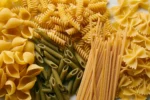While cauliflower pasta has several potential health benefits compared to traditional wheat pasta, there are also some trade-offs. Nutritionally, cauliflower pasta tends to have more fiber, fewer carbohydrates, and less calories per serving. However, it may also have less of certain nutrients like B vitamins and antioxidants found in whole grains. The higher fiber content and lower glycemic index of cauliflower pasta can promote fullness, aid digestion and potentially help manage blood sugar for some people. But cauliflower pasta does not contain gluten, which some individuals require.
Overall, the lower carb and calorie content along with increased fiber and nutrients from cauliflower can make it a potentially healthier alternative to wheat pasta, though individual tolerance and macronutrient needs vary. Both homemade and store-bought options of cauliflower pasta are available.
Nutrition Comparison To Traditional Pasta
Compared to traditional wheat pasta, cauliflower pasta tends to have a distinctly different nutritional profile with several potential benefits.
First, cauliflower pasta contains more fiber. While wheat pasta typically has around 2 grams or less of fiber per serving, cauliflower pasta usually has between 3 and 5 grams of fiber. This higher fiber content can help promote fullness and aid with digestion.
Second, cauliflower pasta has fewer carbohydrates and a lower calorie count. A standard serving of wheat pasta typically has around 30 grams of carbohydrates and between 200 to 250 calories. In contrast, cauliflower pasta typically contains around 15 grams of carbohydrates and between 100 to 150 calories per serving. The lower carbohydrate and calorie contents can make it a more suitable option for some dietary patterns.
Third, cauliflower pasta still retains nutrients from the cauliflower itself. Just like eating cauliflower florets, cauliflower pasta provides some vitamin C, folate, and antioxidants from the cauliflower it is made from. These nutrients help support a number of bodily functions.
However, cauliflower pasta may have reduced concentrations of certain nutrients compared to whole wheat pasta. Whole grains provide B vitamins, magnesium, selenium, and various phytochemicals that can benefit health. Cauliflower pasta is unlikely to contain equivalent amounts of these nutrients due to lacking the wheat germ and bran present in whole grain pasta.
Overall, cauliflower pasta has a distinct nutrition profile when compared to regular pasta. It tends to have more fiber, fewer carbohydrates, and less calories per serving quantity. And although it provides some vitamins and antioxidants from cauliflower, it may lack certain nutrients found in abundance within whole wheat pasta. These differences are important to consider when evaluating cauliflower pasta as a potentially healthier substitute.
Health Benefits Of Cauliflower Pasta
Beyond its nutrition profile, cauliflower pasta may also provide several potential health benefits compared to traditional wheat pasta.
First, the higher fiber content of cauliflower pasta can promote feelings of fullness after a meal. Fiber takes longer to digest and helps signal satiety. The extra fiber in cauliflower pasta versus wheat pasta may therefore prevent overeating and aid weight management for some individuals.
Second, cauliflower pasta has a lower glycemic index than wheat pasta due to its lower carbohydrate content. This means that eating cauliflower pasta may cause a smaller rise in blood sugar compared to wheat pasta. For individuals with blood sugar management concerns like prediabetes or insulin resistance, cauliflower pasta could be a preferable option.
Third, cauliflower contains antioxidants and anti-inflammatory compounds that are retained in cauliflower pasta. The antioxidant glucoraphanin helps reduce oxidative stress while compounds like sulforaphane support detoxification and may benefit brain health. The cauliflower in cauliflower pasta can therefore impart some of these benefits.
However, it is important to note that not all individuals will experience health gains from switching to cauliflower pasta. While the benefits described above could potentially apply broadly, individual factors also come into play.
For example, some people may require gluten for optimal gut health and nutrient absorption. Cauliflower pasta lacks gluten and could be unsuitable for these individuals. Additionally, if managing calories or blood sugar is not a priority, wheat pasta may be equally adequate nutritionally.
Overall, the higher fiber and lower glycemic index of cauliflower pasta have the potential to support digestion, weight management and blood sugar control for many people. Antioxidants and anti-inflammatory compounds from cauliflower may also confer some benefits. However, cauliflower pasta is not necessarily better suited for all individuals, and tolerance for cauliflower as well as personal nutrient needs must also be considered.
Potential Downsides
While cauliflower pasta has some nutritional benefits compared to wheat pasta, there are also some potential downsides to consider.
First, cauliflower pasta may contain less of certain micronutrients found abundantly in whole grain wheat pasta. Whole wheat pasta is a concentrated source of B vitamins like thiamine, niacin and folate. It also provides more magnesium, selenium, zinc and antioxidants from the wheat bran and germ. Cauliflower pasta made from riced cauliflower florets may lack equivalent amounts of these nutrients.
Second, cauliflower pasta does not provide the phytochemicals and antioxidants found within whole grains. Whole wheat contains phytic acid, lignans, beta-glucans and other plant compounds that can benefit gut and heart health. Cauliflower pasta derived from riced cauliflower would not inherently contain these whole grain constituents.
Third, cauliflower pasta lacks gluten, the protein found in wheat and closely related grains. While this can be an advantage for some individuals with gluten sensitivity, others may benefit from including gluten in their diets. Gluten helps form the elastic texture of traditional pasta and also supports gastrointestinal health by fueling beneficial bacteria in the gut. Cauliflower pasta would not provide these potential benefits of gluten.
Fourth, some people may find cauliflower pasta has an inferior texture compared to traditional wheat pasta once cooked. Due to lacking gluten, cauliflower pasta tends to become softer and mushier more quickly during the cooking process. The texture may not match that of al dente wheat pasta for some individuals.
Overall, although cauliflower pasta provides more fiber, fewer carbohydrates and less calories compared to wheat pasta, it also has some potential disadvantages. These include lacking certain micronutrients abundant in whole grains as well as antioxidants, phytochemicals and – for some people – the beneficial effects of gluten. Individual preferences surrounding texture, tolerance and nutrient needs must therefore also be weighed.
How To Make Cauliflower Pasta
Making your own cauliflower pasta at home allows you to control the ingredients and customize the recipe to your preferences. The basic process involves ricing cauliflower florets and then combining the “cauliflower rice” with egg and seasonings to form dough-like mixtures that can be shaped into pasta noodles.
To rice cauliflower for pasta, first cut cauliflower florets into small pieces and place in a food processor. Pulse the cauliflower into a rice-like texture, stopping before it becomes too finely chopped. Alternatively, grate the cauliflower using a box grater or shred using a shredding disk in the food processor. The aim is cauliflower rice that is approximately the same size and texture as Arborio rice grains.
Next, combine the cauliflower rice with one or two eggs and mix to distribute evenly. Add any desired seasonings like salt, pepper, Italian seasoning, garlic powder or nutritional yeast. The eggs help bind the cauliflower rice into a dough-like paste.
Now transfer the mixture to a lined loaf pan, springform pan or other molds. Press the mixture firmly and evenly into the pan(s), using damp hands or the back of a spoon to form an even layer. The thickness of the cauliflower pasta dough should be between 1/2 to 3/4 inches.
Bake the dough-filled pan(s) in an oven preheated to 375°F. Check the pasta dough after 15 minutes and continue baking until it feels firm when pressed, around 20 to 25 minutes total.
Once done, remove the pan from the oven and let the pasta dough cool slightly before slicing into noodles. With a sharp knife, cut crosswise or on an angle into linguine, fettuccine or other pasta shapes, depending on the pan used.
The baked cauliflower pasta noodles can then be cooked directly in boiling water until al dente, around 3 to 5 minutes. Toss with your desired sauce and other toppings to create a low-carb cauliflower pasta dinner.
Commercial Options
For those who prefer not to make cauliflower pasta from scratch, many brands now offer pre-made cauliflower pasta options that are widely available in grocery stores and online.
The first thing to consider when purchasing commercial cauliflower pasta is the ingredients label. The best options will have a very simple list of ingredients consisting of just cauliflower and optionally egg. Any additional starches, binders or fillers should generally be avoided.
Second, check the nutrition facts panel and aim for cauliflower pasta with higher fiber and lower carbohydrate content. Specifically, look for pasta with at least 3 grams of fiber and no more than 5 grams of total carbohydrates listed per standard pasta serving size. This will ensure the pasta provides most of the potential health benefits compared to traditional wheat pasta.
Some good commercial cauliflower pasta brands to consider include Jovial Foods, Banza, Lovinah, Andean Dream and Explore Cuisine. Many of these brands offer different shapes of cauliflower pasta like linguine, fettuccine, elbows and penne. The ingredients typically consist only of cauliflower, egg and seasoning with 3 to 5 grams of fiber and 3 to 5 grams of carbohydrates per serving.
Overall costs for pre-made cauliflower pasta tend to be higher compared to traditional wheat pasta due to the more complex manufacturing processes involved. However, many brands do offer good deals on variety packs with multiple shapes and sizes. Larger box sizes can also provide better value per ounce.
Cauliflower pasta is widely available at major grocery stores in the natural and gluten-free aisles as well as specialty stores that cater to keto, paleo and low-carb diets. It can also be conveniently ordered online from brands’ websites or on stores like Amazon.
In summary, when choosing commercial cauliflower pasta, focus on options with simple ingredients lists featuring just cauliflower and egg. Also aim for pasta with higher fiber content and lower carbohydrate amounts per serving for the greatest potential health benefits. A variety of reputable brands now offer good-quality pre-made cauliflower pasta options that are widely available for purchase.
In conclusion, although cauliflower pasta has some potential benefits compared to traditional wheat pasta in terms of nutrition, it also has certain trade-offs to consider. While the lower carb content and increased fiber can make cauliflower pasta a viable healthier alternative for some people, wheat pasta provides nutrients and attributes that cauliflower pasta lacks. Individual tolerance, preferences and overall diet are important factors when determining whether cauliflower pasta “good for you.”
FAQs
- Is cauliflower pasta gluten-free? Yes, cauliflower pasta is naturally gluten-free.
- Does cauliflower pasta have fewer carbs than wheat pasta? Typically, yes. Cauliflower pasta tends to have lower carbohydrate and calorie content.
- Does cauliflower pasta raise blood sugar? Possibly less so due to its lower glycemic index compared to wheat pasta.
- Does cauliflower pasta have fewer nutrients? It may have less of certain nutrients abundant in whole wheat pasta like B vitamins, magnesium and fiber.




